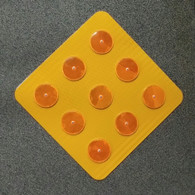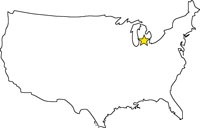Reflecting on the Science of Reflectors
3rd Dec 2017
When you are driving on a long stretch of unlit, monotonous highway in the middle of the night, those reflectors – whether on posts, signs, or along the road itself – are like angelic beacons reassuring you that you're not about to sail off a cliff. In most other circumstances, these ubiquitous prismatic surfaces barely register in our consciousness, even though the story of their creation and evolution is surprisingly interesting.
How They Work
The scientific principle behind reflectors is retroreflectivity, or the return of light off a surface back to the light source with minimal scattering. When the light from a car's headlights hits the reflector, it is refracted and reflected back at different angles as it hits multiple reflective materials. The car is also moving, changing the angles, so we see a prismatic light effect.
How Far They've Come
In 1906, Rudolf Straubel obtained a patent for an invention he called a "reflector", which was a multiple mirror system, designed to reflect light in a precise manner. In 1912, Robert Venner obtained a patent for his method of setting glass spheres in grooves on signs and name plates, which reflected light back for increased visibility. In the 1920s, glass spheres – also called "cataphotes" or "cat's eyes" – became widely used in traffic signs in Great Britain.
Then, in 1939, Harry Heltzer of 3M designed the first reflective sheeting material, which was given the name, "Scotchlite reflective sheeting". That same year, the first traffic sign with reflective sheeting was erected on the outskirts of Minneapolis. The problem was that dirt would accumulate on the surface of the sheeting, which was covered with small glass beads.
Five years later, 3M researchers also developed beads that were more reflective and weather resistant. The innovation here was the addition of a transparent film on top of the beaded sheeting. Referred to back then as "flat top sheeting", we now know this material as "engineering grade" sheeting.
It was in 1963 that the game changed entirely, when the Rowland Brothers developed "prismatic optics", an antecedent to the microprismatics that are used in reflective sheeting nowadays. Because these cube-corners – cut from glass or silica – were so small, prismatic optic materials could finally be incorporated into thin sheets of transparent plastic.
Twenty five years later, in 1988, 3M again revolutionized reflectors when it began manufacturing its diamond grade reflective sheeting, which would later be improved upon in the 1990s. Essentially, glass beads were replaced with "microscopic prismatic reflectors" – around 7,000 per square inch.
Let There Be Light
According to the Federal Highway Administration, retroreflective signs are a crucial component when it comes to reducing nighttime crash rates, especially for older drivers. It is no wonder that reflectors are everywhere, marking sign posts, enhancing delineator posts, marking the ends of roads. Reflectors are also commonly seen on mailboxes and other items to make them more visible.
Take a look at all the different reflector products we have in our comprehensive catalog, or contact us today to find out what type of reflector material best suits your needs. Maybe we can shed some light on that topic for you...




